The Horse is the White of the Eye: Pioneering and the American Southwest in Twin Peaks
by Rob E. King
Published February 2020
Abstract:
This paper examines imagery of the American Southwest and its history in the transmedia of David Lynch and Mark Frost’s Twin Peaks. Elements in season three and The Secret History of Twin Peaks reveal a contemporary perspective on the consequences of western expansion. A social construct, the mythos of the American West has always been propagated through artistic mediums such as paintings, radio drama, and most importantly television and film. Twin Peaks’ contemporary imagery of ghost towns through Rancho Rosa, perspectives on nuclear testing, and ufology expand upon those narratives of the west. This paper argues that when one recognizes the incorporation of the mythos of the American West in the mythos of Twin Peaks—the creators’ usage of the Trinity Test in New Mexico, products of gold rushes and oil booms as well as their abandonment, and Southwestern desert rituals—a larger statement is revealed on the boundlessness of western conquest and the evil that men do.
“This is the water,
And this is the well,
Drink deep and descend.
The Horse is the white of the eye
And dark within.”
—Woodsman, Los Alamos, 1956
In Showtime’s 2017 Twin Peaks: A Limited Series Event, which I will further refer to as season three, the settings for the series moved from the American Northwest to worldwide with an important emphasis on the American Southwest. This essay is focused on the season three narrative, which incorporates the Southwestern states of California, Nevada, New Mexico, and Texas specifically. Of course, in Twin Peaks, there are not only two peaks, there are two original creators, Mark Frost and David Lynch, each bringing different perspectives to the narrative. Together, the creators establish through their individual writing and directing techniques a modernized and unique narrative of the Southwest. As season three incorporates the mercilessness of time and aging upon a people and a place, the Southwestern identity revealed in the series—purposefully or otherwise—also informs audiences of the long-term effects of Western expansion and all that it implies. This essay takes as its subject this unique usage of the American Southwest and its history, both real and mythologized, through instances of old and new West imagery, modern pioneers, and customary as well as non-traditional rituals.
Pioneering on the Frontier and Ghost Towns
Southwest territories and deserts, modern or old, imbue any narrative with attributes of the Western genre as well as their associations to pioneering efforts. In the introduction to Hollywood’s West: The American Frontier in Film, Television, and History, Peter C. Rollins states media’s role in shaping audiences’ perspective on the imagery: “[P]rior to cinema, painting, works of sculpture, and literary representations conveyed the myths of the West. But in our media age, by far the most influential forces in shaping images of the American West have been entertainment films and television programs” (Rollins and O’Connor 1). Yet, those influential images in the early arts as well as in their filmic extensions certainly have origins in the frontier of Western expansion with all of its cowboys, pioneers, and Native Americans. In order to establish the origins of those dramatized images, this essay notes motivations of pioneers and their conquest of the West. Inevitably, some those motivations were under the auspices (propaganda?) of Manifest Destiny, what we now identify as colonial settlement.
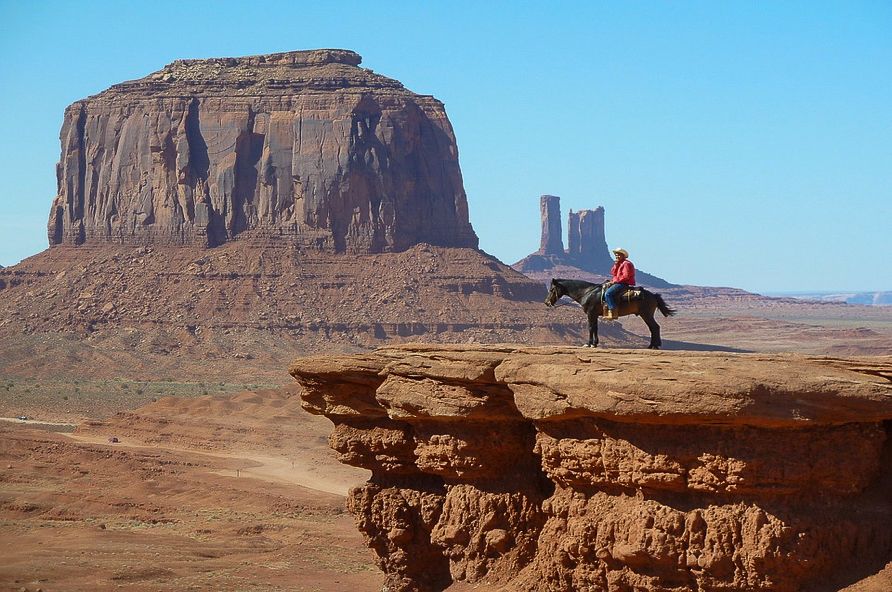
Rollins and O’Connor paint early westward expansion using Frederick Jackson Turner’s optimistic but ultimately myopic “safety valve” theory that states, “when urban pressures built up in nineteenth-century America … the availability of a frontier allowed Americans to move on … relieving the overpopulation, as well as the perceived potential for unrest in industrial cities” (6). Expanding on this point of view in the 1930s, Robert E. Howard, a man of letters and Texas author, argued that the people’s continued movement westward was born of an unsettled desire for fresh country. He implied that just as they established and built structured settlements, the untouched frontier lands continued to call out to them as a kind of prerogative: “I never denied that the pioneers built up the country as completely as possible … yet the fact cannot (sic) be denied that many of them, as soon as the country began to settle up around them moved on into fresh country” (Lovecraft, et al. 700). Early television and film borrowed from these self-assured, perhaps whitewashed, points of view of which Turner and Howard’s are only examples.
Of course, what both Turner and Howard omitted, perhaps naively, in their persuasions is that the Americans moving on—the frontier pioneers, as it were—would inevitably tear into a Native people’s land. It is obvious now to say land was not simply empty and for the taking. This is only highlighted to address what was stated earlier in “what westward expansion implies” as colonizing efforts on that territory became the origin for film and television portrayals of “good” and “bad” Indians. These portrayals eventually extended out of the classic western into the horror genre in the 1980s as is noted by Geoff Bil, when he identifies in Twin Peaks “a horror motif redolent with ghostly emissaries of colonial retribution” (7). Bil has already framed BOB and his role in this motif of “bad” Indian in his powerful essay, “Tensions in the World of Moon: Twin Peaks, Indigeneity and Territoriality,” an indispensable reference. All of these points of view speak to the origin of film and television’s traditional portrayals of the Wild West—lawless, the white man’s prerogative, and once wrangled and subdued, perhaps a cowboy’s Marlboro Country, open plains to be contemplated over a triumphant smoke. Gotta’ light?

Still, in the unceasing westward expansion, whether in accordance with Turner’s thoughts on the safety valve or Howard’s take on the desirability of fresh frontier, the fact can also not be denied that many of the mining towns were eventually abandoned. Additionally, railroads began to direct populations elsewhere, leaving ghost towns as part of the Western identity. Early researcher Royston Willis defines ghost towns as follows: “The term ‘ghost town’ is ordinarily used to apply to a town which still stands but is inhabited by no living person … and which was established and which thrived for a time” (introduction). The point here is that David Lynch and Mark Frost imbue Twin Peaks with a modern image and perspective regarding these ghost towns. In season three, Part 3, Dale Cooper is sent back into the world as Dougie Jones in a depopulated Las Vegas housing development called Rancho Rosa. Note the western imagery in the usage of ranch as in Red Ranch, which, of course, reminds viewers in Twin Peaks mythos of the Red Room. Mark Frost has spoken on his intentions:
The reason Vegas came to mind for me was these images of all these vast tract housing developments that had been built in the anticipation of this endless boom and were then abandoned. They were like ghost towns. They were like three-year-old ghost towns … Very expensive, McMansion ghost towns. I’d never seen that on the screen up to that point, and I thought “well, there’s an image to work with.” (On Story, 13:35-14:14)
If one takes the ghost town metaphor literally, the suspicious addict in one home who yells "119!,” “911” backward, and her son feel like actual ghosts left clinging ignored and dead in the neighborhood they inhabit after its abandonment. The houses as they are portrayed in the series are either vacant, used for dalliances, or are inhabited by methamphetamine addicts, which speaks to our nation’s current socioeconomic, post-2008 recession conditions but also illuminates the modern Southwest identity as a recurring one when considering the following by Chrys Poff: “[f]ilmmakers in the 1910s through 1940s depicted the ghost town as an ambivalent space, occupied by criminal or socially marginalized figures and often remaining just outside the margins of civilized society” (3). Thus, the ghost town image and its inclusion take on added meaning when we think of Agent Dale Cooper or “Richard” appearing in Odessa, Texas in Part 18 of the series. In the previous quote, Mark Frost speaks of “anticipation of this endless boom,” which, in the context of Odessa and its neighboring city of Midland, refers to oil.
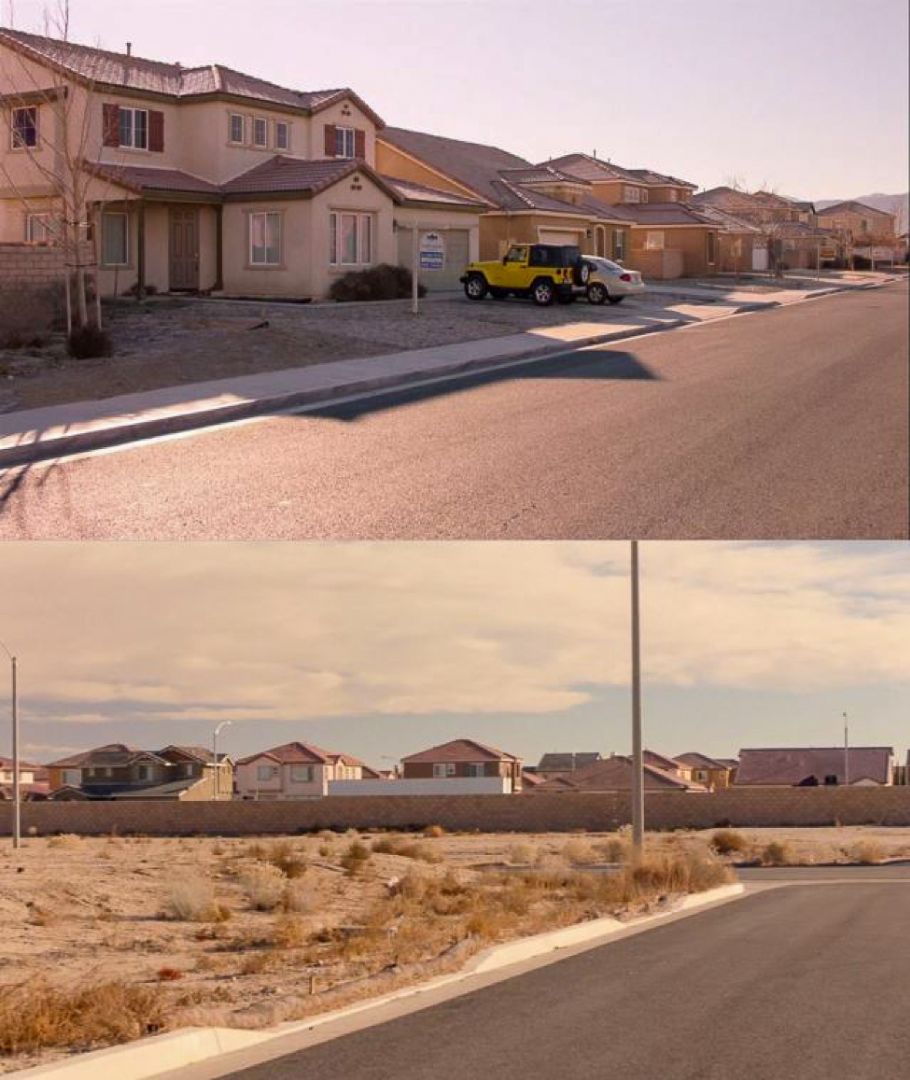
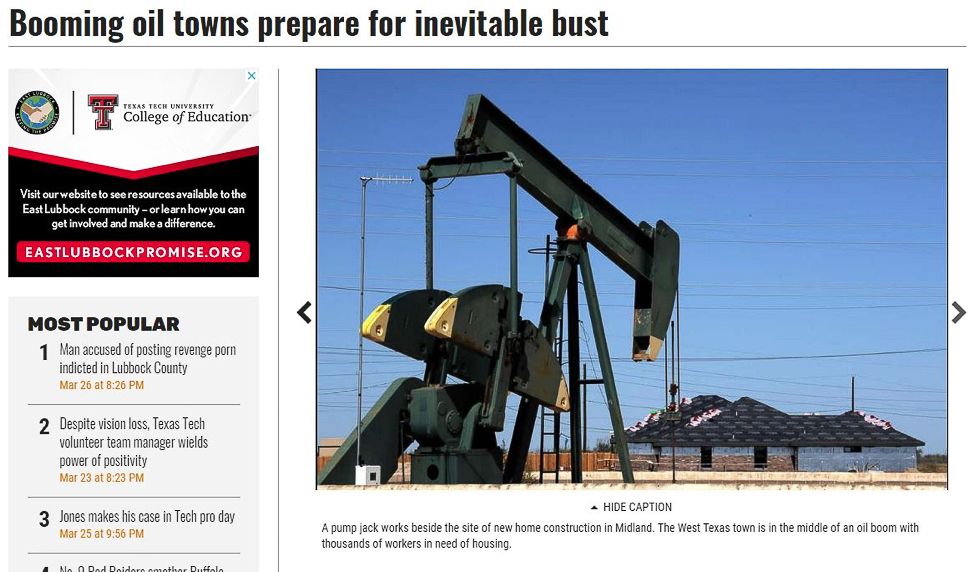
Many ghost towns were products of the gold rush, and it is no mere coincidence that we refer to oil as “black gold.” In Part 18 of Season Three, Cooper, or Richard, wakes in Odessa, TX, a town known for oil production alongside its neighboring city of Midland. Oil also notably appears in Twin Peaks at the entrance of the Black Lodge. Evidencing the actual Midland/Odessa oil boom that began in 2010, a US Census Bureau survey shows that in 2009, 330 building permits were issued. By 2013, the permits had exponentially increased to 1,824 before the upward movement begins decreasing abruptly to 1,025 in 2015 (US Census). This is when the survey ended, but the decrease represents the tapering oil boom, which again cements Frost and Lynch’s commentary as essential to documenting the current imagery of a very real Southwest and its abandoned structures within their narrative. To read more on the conditions following 2015, see “Verify: Texas oil is the new gold rush,” by David Schechter for ABC’s WFAA released as recently as May 2019.
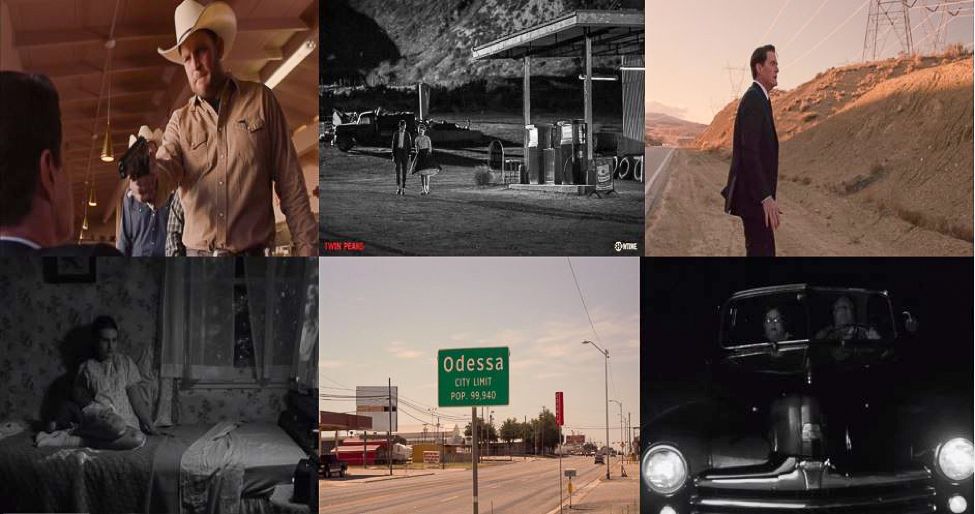
Still, to approach the modern film and television identity of this Southwest, one must first notice a turn in the frontier’s history—a transition—noting that the pioneers eventually pushed westward expansion to its limits with its wasted structures and fortunes gained or lost, including the impact that each of those imply about the land and its native peoples. Eventually the frontier found a way to express itself beyond geographical restrictions. As Greg Grandlin points out in his book The End of the Myth: From the Frontier to the Border Wall in the Mind of America, “In 1941, a physicist described research that was allowing for an ‘intensive attack’ on a ’new frontier’: the impending splitting of the nucleus of an atom” (Grandin, ch 11, par. 2). Lynch and Frost were seemingly attuned to this “new frontier” as they wrote their script.
Trinity Test, 1945
At approximately 8:16 p.m. CST on June 25, 2017, those tuned into season three would experience blacked-out screens which slowly lightened onto a gray desert landscape, where they would hear or read captions to the David Lynch-directed countdown of the Trinity Test. In a pamphlet handed out at White Sands Missile Range only two days a year, it is described thus: “At 5:10 a.m. the countdown started and at 5:29:45 the device exploded … the brilliance of the light from the explosion watched through dark glasses overshadowed the shock wave and sound that arrived later …” (U.S. Army, 8). On the screen in 2017, audiences would watch this same scene played out in twelve minutes of Lynchian effects and possible homage to Stanley Kubrick and/or Stan Brakhage's Dog Star Man, as they were pulled into his portrayal of the explosion and the evils it unleashed.
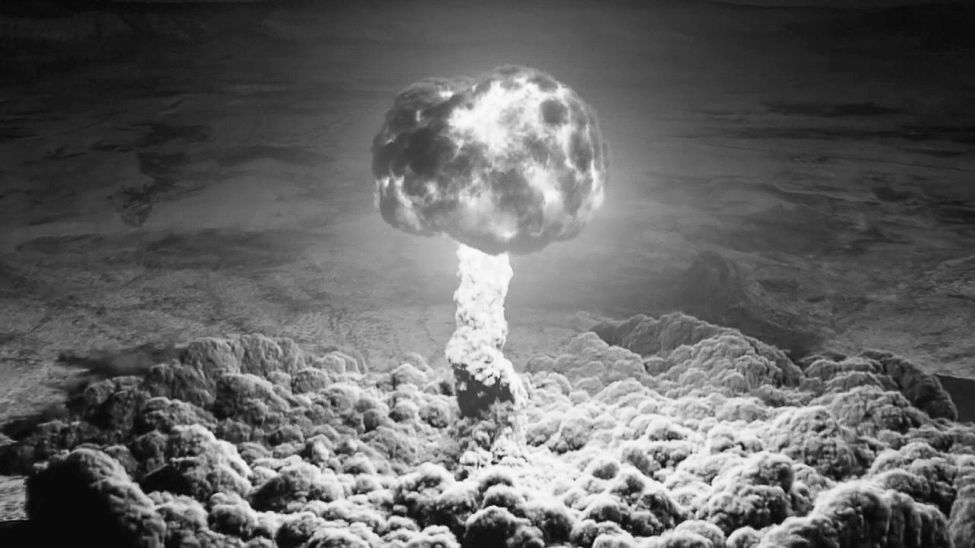
The key, though, is “what it unleashed,” both in Twin Peaks and in changing forever New Mexico’s identity and world culture. Where once man traversed the Southwest seeking the alchemical prize of gold, now man mined the power of the atom. Author Joshua Wheeler cites Joseph Masco’s notion of psychic colonization in that “Fear of radioactive contamination has … colonized psychic spaces … leaving people to wonder if invisible, life-threatening forces intrude upon daily life, bringing cancer, mutation, or death” (par. 22). The psychic colonization cited by Alamogordo-native Wheeler is a reference to the “down winders,” those natives to New Mexico who were afflicted by the radiation from the bomb. Mark Frost and David Lynch’s generations are also products of a certain psychosis stemming from the bomb as framed in The Politics of Twin Peaks. “[F]or Lynch and his contemporaries, the idea of the dropping of the atomic bomb is a threshold event that put an end to an earlier ‘age of innocence’ (not just within America, but globally) and ushered in an age of modern evil” (Joyce, par. 8). Again and again, one sees the gravitational pull on the orbit of frontier and colonial language swirling around the atomic bomb as those notions and audiences get sucked deeper and deeper into the historical tragedy.
That first atomic bomb test took place in the Jornada del Muerto, “Journey of Death,” the expansive desert next to the White Sands outside of Alamogordo, New Mexico. This is a location that Mark Frost clues audiences into in his season three primer The Secret History of Twin Peaks: A Novel. Referencing the location of the “Trinity Test,” Ferenc Morton Szasz says that, “As the site for the world’s first successful atomic detonation, it threw open doors that can never again be closed” (2). That is important language for the season three usage of the region. In 1990, viewers had heard BOB described as “the evil that men do,” which was not lost on Frost in using this first atomic experiment as a penultimate evil act of man as well as an unloosing of unidentified objects. Mark Frost further explains his decision in the same interview as cited above:
My feeling was we needed an origin story for the evil that we had been depicting in this area, and I had mentioned the atomic bomb and White Sands. What if something like this happened … what if it—and again, it’s all metaphorical—but what if something ripped a hole in the space-time continuum and unleashed some … it opened Pandora’s Box. (On Story, 21:34)
The series and history remind us that the atomic explosion did not simply unleash a host of Pandora’s demons; it raised, as Kennedy is well-known to have said, “the nuclear sword of Damocles.”

Season three reconciles that imagery but also extends an international imagery in what Elizabeth Lowery calls “racialized nuclear age panic” (48). In an essay published in Critical Essays on Twin Peaks: The Return, Lowry identifies a rather devastating connection to the Trinity Test in season three through a character named Naido. Here it might also be worth noting that to include international racialized implications regarding the bombing of Hiroshima and Western domination—an extension of Western expansion—points back to notions of the frontier, colonial settlement, and how far that might extend in the way of colonial empire. Per the Southwestern experiment, Lowry speaks to its impact. “Naido is a Japanese woman who has only lumps of flesh where her eyes should be. Naido’s deformity, as well as her inability to speak, evoke the effects of the atomic bombs dropped on Japan” (47-48). Writing for the website, 25YL, author David Titterington’s “Jumping Kokopelli” examines the imagery of the Jumping Man and the character’s connection to Native symbols and spirits—specifically that of Kokopelli, a native god connected to rape and sex magic. To Lowry’s point on Naido, Titterington in his section “The Butoh ‘Dance of Darkness’ Connection” also guides audiences to notice the Jumping Man’s similarity to Japanese Butoh dancers:
Butoh, like Jumping Man, is linked directly to the atomic bombings of Hiroshima and Nagasaki. The Japanese connection is also in the frog-monster, who can be seen as America’s Godzilla. Of course, ours would be born from the Trinity test site in White Sands, New Mexico. These visual languages suggest Jumping Man is about masked trauma in the atomic age. (Titterington, par. 15)
The point that seems to connect them all again leads us to the description of BOB as “the evil that men do” with the Trinity Test in the Jornada del Muerto at its heart.
In the Twin Peaks narrative, the Trinity explosion allowed Judy—an origin for the evil in the series explained as an utukku from Summerian mythology—to spread her seed, which included BOB, onto earth. In reality, the explosion helped the United States end World War II and exact revenge for Pearl Harbor. Yet in theory, humankind’s audacity attracted the attention of other-worldly beings bent on warning us against our own actions, spawning vast numbers of sightings in 1947. Many of these sightings can be seen in Frost’s The Secret History. Still, even before that, ritual may have released something else in the deserts of the Southwest. While some desert rituals are of regional, shamanistic religion and belief, a ritual specific to season three was occult in nature and would follow the atomic bomb’s debut by one year, while preceding the Roswell crash of 1947.
The Babalon Working, 1946
Just as film and television shape our imagery of the Southwest, stories and folklores carry witchcraft and occultism generationally through regional cultures in practice and through oral tradition. These stories and folktales preserved a people’s culture beyond the colonial settlement of Western expansion. Indeed, they seemed to have survived the Spanish colonial period cited by author Nasario García. As seen in his first chapter to Brujería: Stories of Witchcraft and the Supernatural in the American Southwest and Beyond, “Witches and ghostly apparitions, whether real or imagined, have been part of Latino culture in the Southwest since the sixteenth century … Because of their magical power, these stories reach out and appear to be transcendental as they travel by word of mouth throughout the southwestern United States” (7). While the author states that the stories appear to have survived as if by magic, Mark Frost guides Twin Peaks audiences to a surprisingly historical instance of ambitious magical practice in the Southwestern deserts of California’s Arroyo Seco.
The story of Jack Parsons, an important character in Mark Frost’s The Secret History of Twin Peaks, is not myth or folktale. Yet, his desert rituals are still rich portions of the Southwestern narrative and integral to suggested imagery of the Southwest in Twin Peaks. A rocket scientist responsible for the creation of rocket fuel and the foundation of Jet Propulsion Laboratories, Parsons was secretly an occultist and high priest of the Agape Lodge faction of the secret society known as Ordo Templi Orientis (OTO). He was a pioneer of rocketry in the American Southwest, creating the first solid-state rocket fuel in 1942. As a side note, rocketry experiments continue in the Southwest to this very day with Jeff Bezos’s Blue Origin space travel laboratories in far West Texas. Going back to Parsons’s early days creating rockets, the desert was a place of experimentation: “The Parsons’ backyard rapidly became as scarred and pockmarked as the lunar surface itself, and the two young men frequently drove out to the desert or wandered down into the Arroyo Seco to execute their tests” (Pendle 61). It is no wonder then that Parsons and L. Ron Hubbard would choose the desert for their Babalon Working experiment, a sex magic ritual meant to invoke Aleister Crowley’s “Moonchild.”
As Franck Boulégue has pointed out in his online article “Sex Magick and the Scarlet Woman” (Boulégue, par. 7) the golden orb imagery with Laura Palmer’s face in Part Eight of Season Three might signify that she is the Moonchild. Then, further sex magic is implied when Sam and Tracy have sex in New York, perhaps conjuring “The Experiment” in Part 2, and between Diane and Cooper in the hotel in Part 18. Cooper tells Diane before crossing the significant location at “almost exactly 430 miles,” where the noticeable electrical energy is surging off a desert road, “Once we cross, it could all be different” (13:31). Jack Parsons’s Babylon ritual, in particular, was performed at the Devil’s Gate Dam in California’s Arroyo Seco. According to the Twin Peaks narrative, Frosts cements the Jornada del Muerto—remember the Trinity Test—as their ritual site, which is the final word regarding season three.
But the deserts of the Southwest weren’t new to midnight ritual. According to Marc Simmons in his book Witchcraft in the Southwest: Spanish and Indian Supernaturalism on the Rio Grande, “Witchcraft (brujería), sorcery (hechicería), the evil eye (mal ojo), and other forms of occultism have become integral parts of the folk culture of the Mexican nation, thriving in rural hamlet and city alike” (15). So, what Twin Peaks does, again, with this imagery is to make us note that the deserts in the Southwest were the birthplace of as much of America’s mythos as attributed to the Northwest—big foot, serial murders, and UFO activity. Still central to the Twin Peaks mythos is a narrative of rape, which tragically is also a narrative of the deserts. David Titterington explains:
“Conquest, like Twin Peaks, broadens our definition of sexual violence to include nuclear bombs and toxic waste. For example, we know that in areas where uranium is mined, such as New Mexico, Utah, the Four Corners, and the sacred Black Hills in South Dakota, Native people face skyrocketing rates of cancer, miscarriages, and birth defects” (Titterington, Garmonbozia, para 31).
In this secret, or buried, history of the Southwest, pioneering on the frontier’s deserts did not simply provide gold, peaceful landscape, or the adventures of cowboys and indigenous peoples, it opened mankind to unknown forces through nuclear experimentation, ritual, and greed.
In a following brief note, a swath of Southwest UFO sightings was reported following both the Trinity Test and the Babalon Working in 1947. It is no secret that one of the most notorious UFO crash reports came from the frontier of Roswell, New Mexico on June 14, 1947. Astronaut and Lunar Module pilot for the Apollo 14 mission Edgar Mitchell of Hereford, Texas would later make an assertion that connects some of this essay’s content. David J. Hogan summarizes: “The aliens that crashed at Roswell, New Mexico, in 1947, Mitchell said, had been observing American atomic testing at nearby White Sands” (27). Many would expand upon his assertion to make claims that rampant UFO sightings in 1947 had a direct correlation to mankind’s nuclear testing as they had come to earth to warn us of our own reckless experimentation. Twin Peaks has alluded to this history going back to season two with Major Garland Briggs and Windom Earle’s involvements in Project Blue Book. The alien and other dimensional portion of the Twin Peaks narrative is a through-line followed most closely by Frost in his work on season two and in his Secret History that, again, is indispensable to portions of season three.
Conclusion
Given that the show expands world-wide through scenes in Paris and Argentina, an argument could be made, perhaps in another essay, for a statement on colonial empire as the Southwest is concerned. This paper establishes at least those Westward expansionist implications as they pertain to the American Southwest region just as they are portrayed in the series. To be sure, Twin Peaks has always been a series about dual natures—two lodges (black and white), a BOB and a Bobby, a Mike and Mike, two towns (Deer Meadow and Twin Peaks), doppelgängers, and so on. As demonstrated in this essay, season three establishes a fresh dualistic history of the American Southwest and its imagery through newly-built and shameful ghost towns, which represent our history of greed but also our fleeting prosperity. Atomic testing in the Jornada del Muerto desert reminds us of our greatest desperation but also success. Then, hidden desert rituals, be they preserved through oral tradition or written in secret histories, preserve sacrilege and cultures unique to the region. Additionally, the series’ earliest portrayals included mirror imagery, but while American audiences are certainly forced to peer into our own sordid and complicated history, all audiences can experience its synthesis as reflecting both dark truths and golden potential regarding mankind.
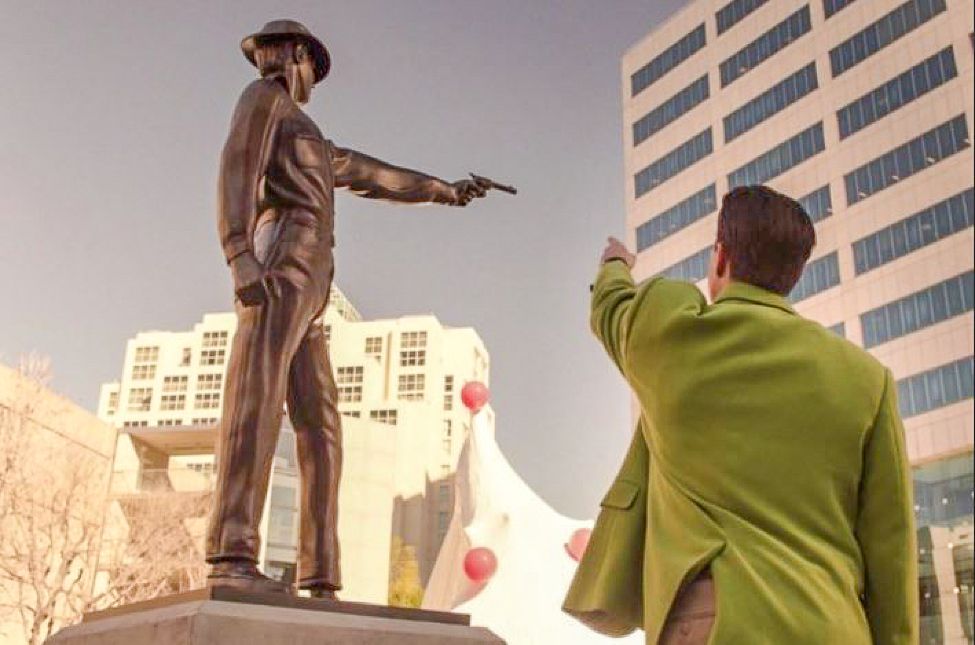
At David Lynch’s 2016 Festival of Disruption, there were promotional posters with backgrounds of the faded chevron design of the Red Room floors with text reading “Infuse the machine with gold.” One could venture to say that for David Lynch, as a proponent of Transcendental Meditation and as an artist, the true frontier is our personal path to fulfillment and understanding. And while David Lynch asks audiences to let their responses to the art form their personal interpretations of the material, even he included imagery of Western ruggedness in the statue that Dougie Jones stares at in Las Vegas: “That bronze statue of a cowboy installed in the plaza outside the Lucky 7 Insurance Agency? It was based on a photograph of Lynch’s father taken when he was nineteen years old and working at a forest lookout station” (Lynch 488). That the majority of the season three narrative is packed into the Western half of the United States is also no mistake, but rather, it is this author’s position that its historical narrative was too ripe with opportunity. This is also a way of saying that the “safety valve” dripped too willingly into a glass from which we gladly drank too deep and descended.
Works Cited
Bil, Geoff. “Tensions in the World of Moon: Twin Peaks, Indigeneity and Territoriality,” Senses of Cinema, Issue 79, July 2016. http://sensesofcinema.com/2016/twin-peaks/twin-peaks-indigeneity-territoriality/.
Boulègue, Franck. "Sex Magick & the Scarlet Woman." Unwrapping the Plastic. 7 Sept. 2017, https://unwrappingtheplastic.com/2017/09/07/sex-magick-the-scarlet-woman/.
García, Nasario. Brujerías: Stories of Witchcraft and the Supernatural in the American Southwest and Beyond. Texas Tech UP, 2007.
Grandin, Greg. The End of the Myth: From the Frontier to the Border Wall in the Mind of America. Henry Holt, 2019.
Hogan, David J. UFO FAQ: All That's Left to Know About Roswell, Aliens, Whirling Discs and Flying Saucers. Backbeat, 2016.
Joyce, Ashlee. “The Nuclear Anxiety of Twin Peaks: The Return,” The Politics of Twin Peaks, edited by Amanda DiPaolo and Jamie Gillies, Lexington, 2019.
Lovecraft, H. P., et al. A Means to Freedom: The Letters of H.P. Lovecraft and Robert E. Howard. First softcover edition., Hippocampus P, 2011.
Lowry, Elizabeth. “Extraterrestrial Intelligences in the Atomic Age: Exploring the Rhetorical Function of Aliens and the ‘Alien’ in the Twin Peaks Universe.” Critical Essays on Twin Peaks: The Return, edited by Antonio Sanna, Palgrave Macmillan, 2019.
Lynch, David, and Kristine McKenna. Room to Dream. Random House, 2018.
Rollins, Peter C., and John E. O’Conner. Hollywood’s West: The American Frontier in Film, Television, & History. UP of Kentucky, 2009.
“On Story 809: A Conversation with Mark Frost.” YouTube, uploaded by Austin Film Festival, 11 June 2018, https://www.youtube.com/watch?v=8Q7Rgyssx9A.
Pendle, George. Strange Angel: The Otherworldly Life of Rocket Scientist John Whiteside Parsons. Houghton Mifflin Harcourt, 2005.
Poff, Chrys, and Jane Desmond. “The Western Ghost Town in American Culture, 1869–1950,” 2004. ProQuest Dissertations and Theses.
Simmons, Marc. Witchcraft in the Southwest: Soanish & Indian Supernaturalism on the Rio Grande. U of Nebraska P, 1974.
Szasz, Ferenc Morton. The Day the Sun Rose Twice: The Story of the Trinity Site Nuclear Explosion, July 16, 1945. U of New Mexico P, 1984.
Titterington, David. “Jumping Kokopelli,” 25YL, December 2018, https://25yearslatersite.com/2019/02/06/jumping-kokopelli/.
---. “Garmonbozia and The United States’ Demonic Show,” 25YL, January 2019, https://25yearslatersite.com/2019/02/27/no-stars-the-united-states-demonic-shadow/.
US Army, White Sands Missile Range, NM. Trinity Site, July 16, 1945. White Sands Missile Range, [2017].
US Census Bureau. "Number of New Privately Owned Housing Units Authorized by Building Permits in Midland County, Texas from 2005 to 2015." Statista—The Statistics Portal, Statista, www.statista.com/statistics/614869/us-residential-building-permits-midland-county-texas/.
Wheeler, Joshua. Acid West: Essays. Farrar, Straus, and Giroux, 2018.
Willis, Roysten E. Ghost Town of the South Plains. 1941. Texas Technological College, Master’s thesis.

